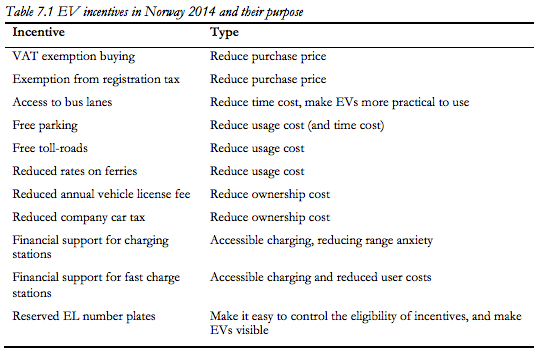
Why There is Less Marriage
October 21, 2014
You’ll Need a License for That
October 23, 2014During morning rush hour, a 51 minute drive to Oslo will take you 19 minutes if you drive in the bus lane. To save more than 30 minutes each weekday, you just need to buy an electric car (EV).
Irresistible Incentives
Norwegian legislators created an irresistible list of incentives to maximize electric vehicle purchases. The list has been so attractive that a 50,000 vehicle goal for 2018 will probably be met in 2015. The allure of the bus lane was sufficient motivation for 12 percent of all electric car buyers. Another 48 percent liked the tax savings. Through taxes alone, someone buying a Tesla S model could pay $135,000 less. Then, if you commute into Oslo, annually, you can save $1400 in road tolls and $5000 on parking. The environment? It ranked lower than the dollar incentives.
Here is the whole list of perks from the Norwegian Centre for Transport Research.

From: “Electric Vehicles: environmental, economic and practical aspects”
And these are the reasons current owners would again purchase an EV.

From: Norwegian Centre for Transport Research
Tradeoffs
Needless to say, there is no such thing as a free charge.
Norway estimates it receives $650 million less revenue because of its EV policy. People driving conventional cars complain that they have access to fewer parking spaces. Others say the demand for public transport has declined because a subsidy has made the substitute–a second car–so much cheaper. Meanwhile, ferryboat operators get paid the normal passenger fare, but get nothing for the electric cars they transport. On one route, that meant 9226 cars generated no revenue during a seven-month period except for the people they carried.
Also, you can imagine the response to a study that concluded 85 percent of bus lane traffic is the EVs. Comments ranged from indignation over affluent Tesla S Model drivers having the benefit to bus drivers who are angry over delays. One concerned bus driver said, “The delays have a cost for society. Time lost by thousands of our passengers in traffic is far greater than that gained by a few dozen electric car drivers.”
On the benefit side, carbon emissions, noise and space have been the focus. For the general environmental impact, citing battery production, I unearthed no definitive conclusion. Locally though, researchers expect less noise and fewer pollutants while space use would remain the same. Also, we should note that because of its oil wealth, Norway has a lower opportunity cost from the krone cost of the subsidy than a less affluent nation would experience.
Our Bottom Line: Subsidies
While we can debate whether the trade-offs are worth the cost or not, we can all agree that the electric vehicle subsidies changed a slew of incentives that ranged from car purchases to commuting and parking decisions.
![econlifelogotrademarkedwebsitelogo[1]](/wp-content/uploads/2024/05/econlifelogotrademarkedwebsitelogo1.png#100878)



